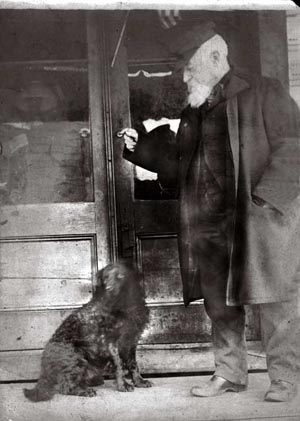 Tideflats ball field plat filed May 3, 1903 By June Allen April 26, 2003
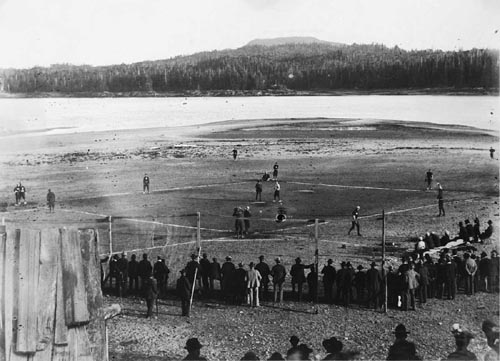 Photographer: Harriet Hunt Donor: Forest J. Hunt, THS 62.4.1.29 Photograph courtesy Ketchikan Museums The town loved its baseball! There were players and fans aplenty among the 900 who lived in the new city in 1903. The Ketchikan Mining Journal of May 3 had announced that a plat of Ketchikan baseball grounds had been filed in the records office! And this particular summer day in 1903 "the boys" - boys of a wide range of ages - were playing ball on their own, duly recorded field, a diamond laid out on the tideflats of Ketchikan Creek, with outfields part lumberyard and part tidewater! It's been said that at extreme high tide and with a good sou'easter, home plate could be under 14 feet of water! The only place large enough and acceptably level enough for a ballfield in all of Ketchikan, Alaska, at the turn of the 20th century was at the mouth of Ketchikan Creek - and that piece of available real estate was free of salt water only for a steadily diminishing time twice a day! At low tide the creek burbled through a narrow low-tide bed worn into the slightly slanting sandy expanse that, filled at high tide, formed the creek's broad estuary. Where the town's more or less solid-ground structures began a wooden trestle bridge that spanned the creek's mouth from west to east. Today's Stedman Street.
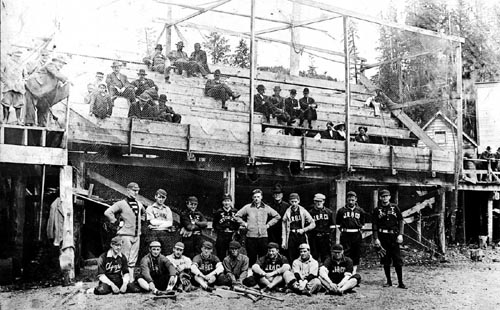 Ketchikan ball team and grandstands over near mouth of the creek- where games played where Federal Bldgs now stand -& had to stop when tied came in Jim Sayles- Ed Williams- & Laurence Kubley among those sitting on ground-...(Scratched out Harw Stackpole- Clayton Smith)) 1st below John Patching, Jim Sayles -- Bob Robinson- Ed Williams-Jack Mac Bride ... Top row - Moran-Ed Richmond 2 unknown- Jim Smith; Fred Purinton- 3 unknown- Joe Mahony Donor: Bertha Hunt Wells - Photograph courtesy Ketchikan Museums Each low tide exposed the new ballfield, which might be littered with soggy bark, a dead as a doornail humpy or more in late summer, or sometimes a fugitive log or the carcass of an abandoned skiff brought in by the twice-daily high tide. It was trash that dedicated ball players had to clear before each game. In deep right field was "Burkhart's sawmill" (later named Ketchikan Spruce Mill). Such a strangely configured ballpark had to have some unique ground rules! So, when a ball was batted to right among the piles of lumber and sawmill rubbish, it went for two bases, and if it landed on the mill's dry kiln, it was a home run. On the other side, a batted
In those early days, Forest J. and Harriet Hunt's little black dog "Toby" would swim out and retrieve the balls hit into the water! But, like the Field of Dreams "If you build it.", to Ketchikan's curious ballfield "they did come." Teams came from Juneau and from Prince Rupert and Anyox and from Metlakatla. And just as baseball had become the national sport of the USA it became the traditional sport of Ketchikan. Sometime before 1909 a grandstand was built that served as well as a bandstand for the Metlakatla teams that were accompanied by the Metlakatla's famous band. The little town on Tongass Narrows had no trouble raising enough money, in the range of $400 or so - a sizeable sum back then - to bring the Prince Rupert team north for a series of games. And then Prince Rupert raised money for Ketchikan's fare south. Word of Ketchikan's zeal for baseball got around over the years! Passing Navy ships stopped to challenge the confident First City players. So did teams from other vessels sailing the Inside Passage. The dedication to the game was so intense that it was common for tourists and steamship crews to pause and watch Ketchikan's pitcher-catcher batteries practicing for all to see on the downtown docks. Baseball helped put Ketchikan on the map. Almost any oldtimer memoir of those olden days includes mention of the grand old sport. Here's an account from the August 9, 1912, issue of the Ketchikan Miner after the arrival of a ship bringing a visiting team to town: "The Juneau or near-Juneau all star baseball team arrived from the north on the Alameda yesterday too late for the game on that day. Owing to the fact the Ketchikan baseball field on the tideflats, it is necessary to take the tide at the proper time in order to keep the Juneau stickers from losing the ball in the sea." So the Sunday game had to be cancelled. After a paragraph describing the grand welcome given the Capital City team, the article mentions a Grand Ball thrown in the visitors' honor. Then it goes on to describe the following day's game - the "Best game of ball ever played in Southeastern Alaska!" - "a masterpiece" - with Ketchikan winning 2 to 1. 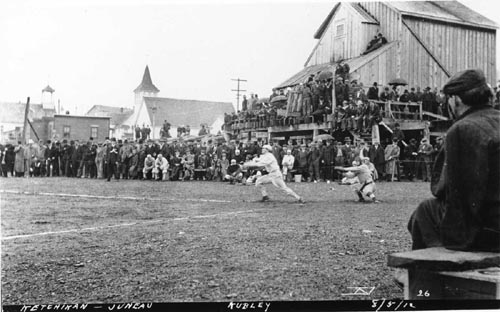 Photographer: David Nicoll Donor: Lawrence Kubley - Photograph courtesy Ketchikan Museums "It opened with Juneau to bat and Hooper (pitching) for the locals, who fanned out the first two men up. Dahl got a two-bagger but died at third when Malley failed to reach first. Then (Ketchikan's) Murphy slammed one out to left field but failed to reach first. Kubley then put one on top of the dry kiln and brought in the first home run of the season!" The story continues, "in the first half of the second, with three men on bases, it looked as though Juneau was going to more than tie the score, but Hooper pitched himself out of the hole in elegant shape." In the third inning, Juneau batter Malloy picked out " a nice one, and slammed it into the lumber pile for a home run, tying the score." It was in the fifth when "Cook (Ketchikan) connected for a nice little one, which landed him on first. By good playing on the part of his teammates and a balk by the pitcher he was able to complete the circuit, boosting Ketchikan's score to two runs. Where it stood to the end of the game." No one argued with the umpire, Ketchikan's Judge and Police Justice Harvey Stackpole. Burnes of Juneau made base decisions. And, in spite of Ketchikan glorious showing in that first game, they lost 11 to 2 the following day. The newspaper blamed the loss on the facts that "it was cold, and it was wet" and the game was called after seven innings because the Juneau team's boat had arrived to take them home. Fred Purinton managed some of those early-day Ketchikan teams. Purinton is remembered as "a good mixer." He was also manager of David Gross's Dream Theater on Front Street and his job allowed him the daytime hours to devote to the team. Known as the man who originated the slogan "In the meantime go to the Dream," he was known as a showman who could make people sit up and take notice. And take notice they did in 1914 when Fred ordered a goat shipped up to be the Ketchikan team's mascot. He insisted it was worth it, just to have the goat eat tin cans and paper litter scattered about town. 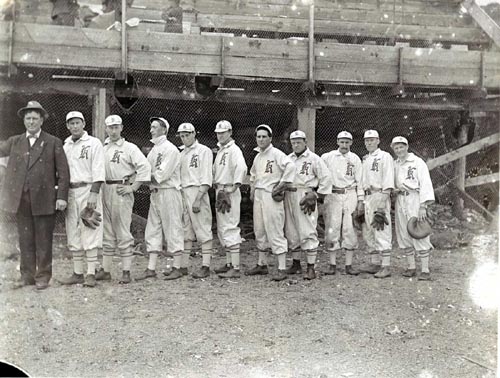 Photographer: Harriet Hunt Donor: Ketchikan Public Library - Photograph courtesy Ketchikan Museums It was also in those teen years of the 20th century when Prince Rupert's team came into existence as the Canadian town grew after becoming the Pacific Coast terminal of the Canadian National's trans-Canada railway. The boys from Canada provided stiff competition to the Ketchikan athletes. In 1914, on the Fourth of July weekend - always a big baseball holiday - Prince Rupert scored an "accidental" winning home run, an event the boys talked about for years. It seems that the Canadian catcher at his turn at bat knocked the ball out of the diamond and it somehow got "lost" in the watery outfield, which made what should have been a two-bagger into a home run. It was later explained that the ball landed about 40 or 50 feet back of second base, in the one spot where the ground dropped off at a sharp angle - too deep to retrieve the ball. In 1917 another baseball team stood up to be counted. The boys came from a new little town called Anyox, a short-lived mining town located somewhere on Portland Canal, on the Canadian side of the border (?). The Anyox boys arrived in Ketchikan aboard the Prince John to celebrate the Fourth of July with their neighbors. And to play baseball! It was Metlakatla that presented Ketchikan with some real challenges. Some of those Metlakatla boys who had been interested in furthering their educations had been sent to college in Carlisle, Penn. Baseball, the nation's favorite pastime, was seen as one of their most important studies! They brought their skills back to Alaska and gave the Ketchikan boys a run for their money. 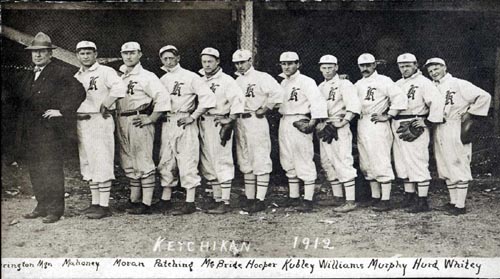 Photographer: Forest J. Hunt Puritan- Manager, Mahoney, Moran, Patching, Mc Bride, Hooper, Kubley, Williams, Murphy, Hurd, Whitey Donor: Lawrence Kubley - Photograph courtesy Ketchikan Museums Today, photographs of those early teams from both Ketchikan and Metlakatla hang on the rear wall of the Sourdough Bar, along with photos of the teams in action. Among the Ketchikan players pictured is Lawrence Kubley, who came to Ketchikan in 1904. Kubley was one of the town's star baseball players for many years, and in his later years would stand in front of the telegraph office on Front street and read the latest play-by-play coverage of World Series games to a rapt audience. The tideflats ball field was unique, it was serviceable. But all things come to an end. Plans were under way for a new, completely dry field on Upper Ketchikan Creek. More change, in the form of progress and federal dollars, came to Ketchikan in the late '20s and early '30s when the Ketchikan Creek tideflats were dredged and Thomas Basin created for the town's mosquito fleet of trollers. 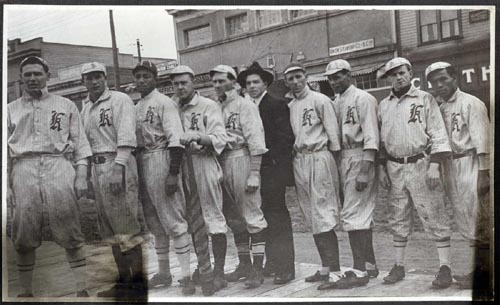 Ainsworth, Mahoney, Josiah, Jangen, Kubley, Stackpole - Manager, George Engel, Rice, Erickson, Reyce Donor: Lawrence Kubley - Photograph courtesy Ketchikan Museums But even before, work on a new ballpark was under way on the upper creek, at least on paper. As early as 1920 the Ketchikan Chronicle announced, "Ballpark Will Be Ready by First of April 1921. Contract is let for completion of job which was started up the creek a year ago. Tennis courts, too" The Chronicle went on to say that preparation would include the foundation work for the city park, for construction of tennis courts, and for the new ballfield. The story added, "Ketchikan will have a regular honest-to-goodness baseball park, one which it will not be necessary to share with shellfish or humpies." The little city park was being created on Park Avenue from an abandoned fish hatchery. A new ballpark was being created just across the street. Wally Kubley, Lawrence Kubley's son, was bat boy for the Ketchikan team his dad managed in the mid- to late '20s. Wally remembers his dad and other ball players and managers working on the site, sluicing the hillside property and diverting water away from what is now Walker Field. So either completion didn't arrive on schedule or needed additional work as time passed. Once completed, improvements to the ballfield were added over the years. One year a large deposit of sand was discovered on the cemetery hillside when rock was being blasted to open up space for new plots. The sand was trucked to the ballpark and exchanged for
The new ballfield was named for one of Ketchikan beloved characters, Norman "Doc" Walker - pharmacist and drug store owner, Ketchikan Mayor 1930-32, and longtime Territorial Senator. It was in 1929 that organized youth leagues were formed. There was the senior division, composed of high school boys in charge of Vern Stedman. There was the U.S. Keds division of slightly younger boys managed by Stanley Oaksmith. Kids just starting their Babe Ruth careers belonged to the Craddock Terry Cubs, with Clarence Foss as their manager. Each division was comprised of four teams with names such as Checks, Deposits, Polar Bears, Kilowatt Kids, Go Getters, and Charcoal Point Giants - not a surprising name to be chosen by the Charcoal Point gang! (An in-joke for the oldtimers.) Youth baseball came of age. It continues to this day. Players and their dedicated coaches are honored during this Month of May, celebrating 100 years of baseball in Ketchikan. There is no tribute or scale model of Ketchikan's first and most unique tideflats ballfield, no photos or busts of pioneer players in the Baseball Hall of Fame in Cooperstown, N.Y. But there oughta be.
All rights reserved. Not to be reprinted in any form without the written permission of June Allen.
|
|||
